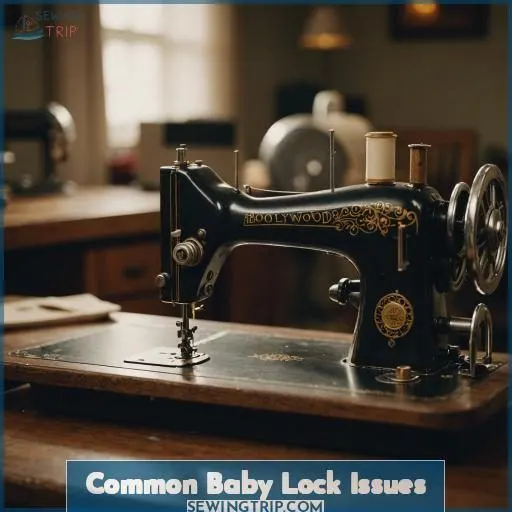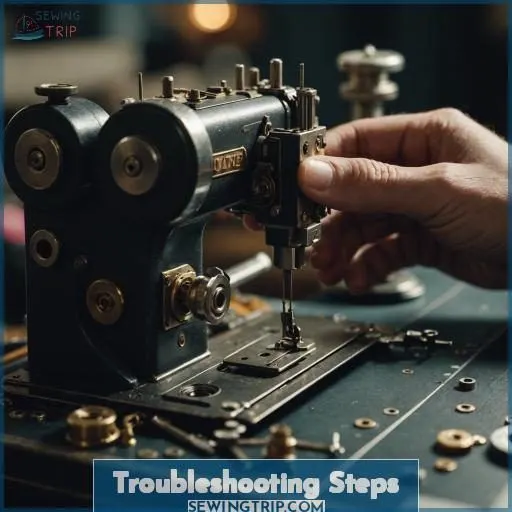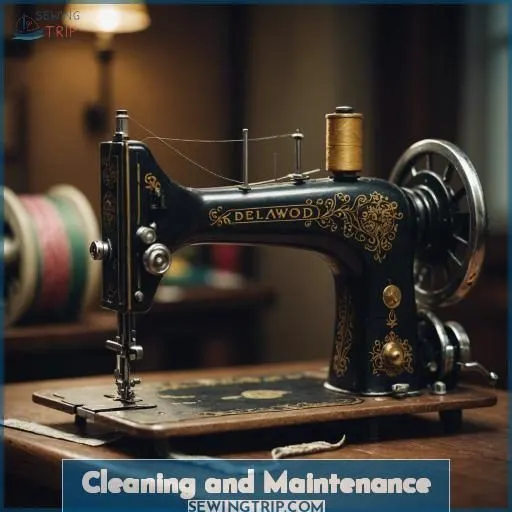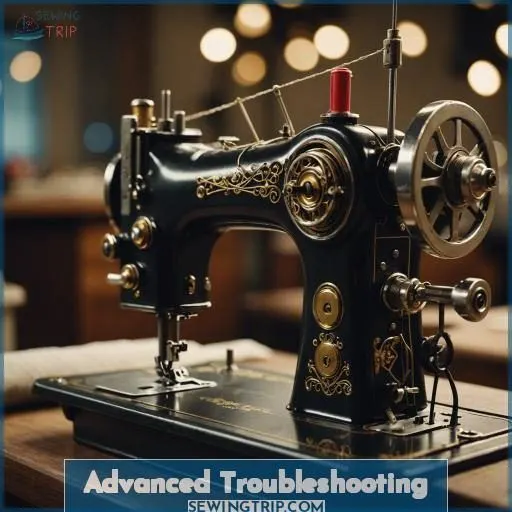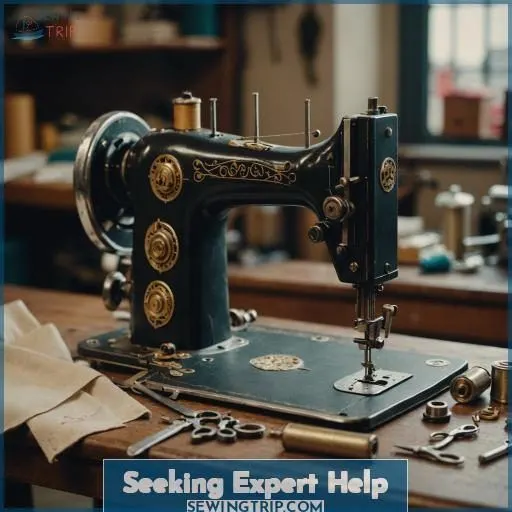This site is supported by our readers. We may earn a commission, at no cost to you, if you purchase through links.
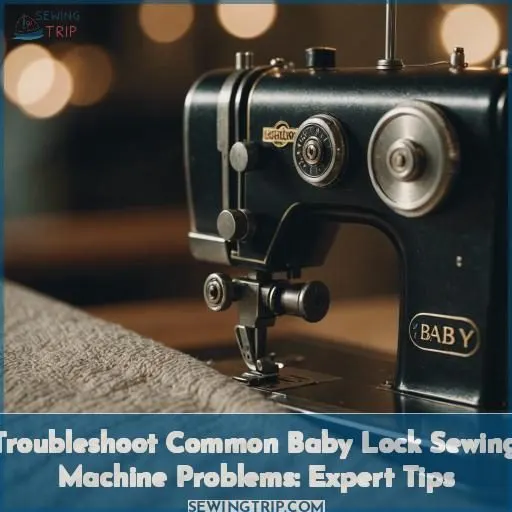 As a Baby Lock sewing machine owner, you’ll occasionally face common issues like the needle not descending, thread tangling, or error codes.
As a Baby Lock sewing machine owner, you’ll occasionally face common issues like the needle not descending, thread tangling, or error codes.
First, reset your machine, rethread properly, check the bobbin area for lint or damage, and clean debris.
If problems persist, remove the faceplate and lubricate the shuttle race.
Check for updates and recalibrate if needed.
Maintain regular maintenance by oiling moving parts and removing lint buildup.
For more advanced troubleshooting, consult online manuals, join expert forums, or seek professional servicing – you’ll soon have your Baby Lock running smoothly again with the right guidance.
Table Of Contents
Key Takeaways
- Regular maintenance, including cleaning and oiling, can help prevent and resolve common Baby Lock sewing machine issues.
- Troubleshooting steps, such as resetting the machine, rethreading, and checking the bobbin and needle plate, can often resolve common problems.
- For more advanced issues, removing the faceplate and lubricating the shuttle race may be necessary.
- Seeking professional help, such as from licensed experts or online forums, can provide valuable insights and solutions for specific machine problems.
Common Baby Lock Issues
Is your Baby Lock sewing machine giving you trouble? Don’t worry – you’re not alone. Many Baby Lock owners frequently encounter issues like a needle that won’t descend or persistent thread problems. But with the right troubleshooting steps, you can get your machine back in tip-top shape.
Needle Not Descending
If your Baby Lock sewing machine is experiencing a needle malfunction, where the needle fails to descend, there are several steps you can take to troubleshoot the issue. First, ascertain that the thread tension isn’t too tight, as this can cause the needle to break or the thread to come out of the thread tension disc or a thread guide. If the upper thread is breaking or coming out of the thread tension disc or a thread guide, you may need to rethread the machine or replace the thread.
Another possible cause of the needle not descending could be lint or dust accumulated in the thread tension disc. To address this, you should cleanse the thread paths of the upper threads regularly. Additionally, you may need to check the bobbin thread for breakage or running out, as this can also cause the needle to stop descending.
If the issue persists, you may need to remove the tension dials and cleanse any lint or dust between the felt washers. If the bobbin thread is tangled in the hook, you should remove the thread jammed and cleanse the hook. If the bobbin is scratched or damaged, you may need to replace it with a new one.
For more advanced troubleshooting, you may need to remove the faceplate or check the take-up mechanism for any issues. In some cases, lubricating the shuttle may also help resolve the problem.
If you’re still unable to fix the needle malfunction, you may want to ponder seeking professional help. Licensed experts are available 24/7 to assist with Baby Lock sewing machine repairs, and they can provide a 100% satisfaction guarantee. Additionally, regular maintenance, such as cleansing the machine and oiling the needle when performance becomes poor, can help prevent future issues.
Upper/Bobbin Thread Problems
Concerning upper/bobbin thread issues with your Baby Lock machine, consider these steps: Firstly, verify that the needle size matches your fabric. Adjust the thread tension and examine the bobbin case for any blockages or problems. If difficulties persist, consult with a small appliance technician or explore Baby Lock’s troubleshooting assistance. Remember, routine maintenance and cleaning help avoid these issues.
Error Messages
If you’re encountering error messages on your Baby Lock Ellegante 2 embroidery machine, here are some troubleshooting steps:
- Check for software updates: Make sure your machine’s software is current. Go to the Baby Lock website to get the latest software updates for your Ellegante 2.
- Hardware reset: Try resetting the machine by unplugging it from the power source for a few minutes, then plugging it back in. This may fix software-related issues.
- Firmware update: If the problem continues, you may need to update the machine’s firmware. This can be done through the machine’s settings menu or by contacting Baby Lock’s customer support.
- Display issues: If you’re seeing error messages on the machine’s display, make sure the display is clean and free of debris. If the problem persists, consider contacting Baby Lock for further help.
- Calibration problems: If the machine isn’t recognizing the hoop, check that the smaller screw on the carriage arm is tight. If the problem continues, follow the hoop calibration procedure in the machine’s manual or on Baby Lock’s support website.
Troubleshooting Steps
If your Baby Lock sewing machine is giving you trouble, start by resetting the machine. Next, carefully rethreading the machine and checking the bobbin and needle plate can often resolve common issues.
Machine Resetting
To reset your Baby Lock sewing machine, make sure the power cord is disconnected. Press and hold the button for 10 seconds, then let go.
Connect the machine back in and wait for it to power up. If necessary, update the firmware, change the language, or use the menu to adjust button sensitivity.
If the problem continues, consider using a new bobbin case or needle, or clean the machine. Regular servicing annually can also help maintain best performance.
Rethreading Techniques
After resetting your Baby Lock sewing machine, it’s time to conquer the skill of rethreading. Here’s how to guarantee a seamless stitch:
- Choose the appropriate needle type for your fabric, avoiding tension troubles.
- Utilize high-caliber thread to prevent breakage and maintain steady thread tension.
- Modify fabric tension and stitch length for a harmonious interplay between threads.
- Clean the take-up area and tension discs according to cleaning instructions, keeping your machine in top condition.
Bobbin and Needle Plate Checks
To guarantee that your Baby Lock sewing machine is in prime condition, it’s imperative to inspect the bobbin and needle plate periodically. Commence by scrutinizing the bobbin tension, which ought to be in equilibrium with the needle thread. Subsequently, apply lubricant to the needle to prevent thread breakage.
Inspect the thread trajectory for any impediments and modify the tension settings suitably. Examine the thread nests for debris and clean them as required. Regularly lubricate the tension discs for seamless operation.
Should you continue to encounter difficulties, consider seeking professional maintenance for timing modifications and hook timing mechanism issues.
Cleaning and Maintenance
Routine cleaning and upkeep are essential measures in resolving typical Baby Lock sewing machine problems.
To eliminate debris, you’ll need to:
- Disconnect the needle plate
- Disconnect the bobbin
- Disconnect the bobbin holder
- Thoroughly clean the area with a lint brush or compressed air
Afterward:
- Apply a few drops of sewing machine lubricant to the shuttle mechanism
- Use a small brush or cloth to remove lint buildup from the tension discs
Debris Removal
To tackle debris accumulation in your Baby Lock sewing machine, follow these steps:
- Remove needle plate, bobbin, and bobbin case: Carefully take apart your machine to access these components.
- Clean area of debris: Use a soft-bristled brush or compressed air to remove any lint, thread, or other particles from the needle plate, bobbin, and bobbin case.
- Check tension discs: Inspect the tension discs for any buildup of debris that may be causing thread tension issues.
Oiling the Shuttle
To keep your Baby Lock Ellegante 2 Embroidery Machine in good condition, it’s essential to oil the shuttle on a regular basis.
This process, called shuttle lubrication, aids in the smooth operation of the machine.
Begin by taking out the needle plate, bobbin, and bobbin case.
Clean the area of any dirt, then put a few drops of oil in the middle of the shuttle.
Put the parts back in place and run the machine to spread the oil around.
Regular shuttle maintenance guarantees the machine will last longer and work as well as it should, just like keeping the oil in a car engine does.
Tension Discs Cleaning
To guarantee the highest possible stitch quality, it’s essential to clean and maintain your Baby Lock sewing machine’s tension discs.
Begin by detaching the needle plate, bobbin, and bobbin case.
Clear the area of any debris, then lubricate the tension spring.
Unthread the machine and lift the presser foot to spread the tension discs.
Run a scrap of fabric through the top tension to remove lint and debris.
Finally, rethread the machine with correct tension and thread path.
Regular cleaning and maintenance will keep your machine functioning optimally.
Advanced Troubleshooting
If the previous troubleshooting steps fail to resolve the issue, you’ll need to take more advanced measures. Remove the faceplate to inspect the take-up mechanism for any entangled threads or debris; lubricate the shuttle area with a few drops of sewing machine oil to guarantee smooth operation.
Faceplate Removal
After giving your machine a thorough clean, it’s time to dive deeper with faceplate access.
Locate those sneaky screws—safety precautions in mind, of course.
Peeling back the faceplate reveals the heart of your Baby Lock, but tread lightly.
You’re venturing into territory where warranty considerations loom large.
It’s like opening a secret door, exposing the internal mechanisms without stepping into no-man’s land.
Take-Up Mechanism Check
When addressing thread tension difficulties in your Baby Lock Ellegante 2, it’s crucial to examine the take-up mechanism. The take-up mechanism is responsible for managing the thread tension and thread path. If the shuttle hook isn’t functioning properly, it could result in uneven thread tension. To examine the take-up mechanism, follow these steps:
- Remove the needle plate, bobbin, and bobbin case.
- Clean the area of any debris.
- Inspect the take-up mechanism for any signs of wear or damage.
- If necessary, adjust the take-up mechanism according to the manufacturer’s instructions.
Shuttle Lubrication
The shuttle is an essential part of your Baby Lock sewing machine, responsible for bringing the bobbin thread to the needle. Proper oiling is important to guarantee smooth operation and avoid thread breakage. Here’s how to oil the shuttle:
- Remove the bobbin case: First, take out the bobbin case from your sewing machine. This will let you reach the shuttle and its components.
- Clean the shuttle: Before adding any oil, clean the shuttle well. Remove any dirt or lint that may have gathered on its surface. You can use a soft brush or canned air to remove the dirt.
- Oil the shuttle: Put a small amount of sewing machine oil on the shuttle. A few drops should be enough. You can use a small brush or a cotton swab to put the oil on the shuttle’s moving parts, such as the hook and the race. Be sure not to over-oil, as this can cause extra oil to drip onto your fabric.
- Put the machine back together: Once the shuttle has been oiled, put your sewing machine back together. Be sure to put back the bobbin case and any other parts that were taken off during the cleaning process.
- Test the machine: After putting the machine back together, test it to make sure that the shuttle is working properly. Check for any signs of oil leaking or thread breakage.
Seeking Expert Help
If your Baby Lock sewing machine issues continue despite thorough troubleshooting and maintenance endeavors, refer to the comprehensive online manuals and guides provided by the manufacturer.
These offer detailed instructions and solutions for various concerns.
Moreover, seeking professional service is strongly recommended, as skilled technicians possess the knowledge to diagnose and rectify intricate problems.
This will ensure that your machine functions at its optimal level.
Online Manuals and Guides
When you encounter difficulties with your Baby Lock sewing machine, the initial action is to refer to the accessible manuals and guides.
These materials furnish diagnostic measures, cleaning methodologies, and maintenance recommendations to assist in resolving prevalent issues.
Should the manual prove insufficient, consider seeking professional guidance.
Expert forums and online sources can offer valuable insights and suggestions specific to your particular machine.
Bear in mind, preventative actions surpass remedial ones, hence regular cleaning and maintenance are imperative for exceptional performance.
Professional Servicing Recommendations
Regarding professional servicing advice for Baby Lock sewing machines, several key elements warrant attention.
The cost and value of servicing should be evaluated against the warranty protection and servicing frequency.
Timing adjustments and lubrication intervals are pivotal for upholding the machine’s functionality.
It is paramount to comprehend that periodic servicing can prevent costly repairs in the future.
Bear in mind, a well-cared-for machine will not just perform optimally but also endure longer.
Utilizing Expert Advice Forums
When you’re stumped by a Baby Lock sewing machine problem, expert advice forums can be your best friend. Here’s why:
- Expert Guidance: Connect with licensed experts who can provide 24/7 support, ensuring 100% satisfaction.
- Community Support: Tap into a community of users who’ve faced similar issues and can share their experiences.
- Shared Knowledge: Learn from others’ successes and failures, allowing you to troubleshoot more effectively.
Frequently Asked Questions (FAQs)
How to adjust stitch length on Baby Lock?
Discover the secret to perfecting stitch length – on your Baby Lock, simply rotate the length dial until the preferred setting coincides with the prominent red indicator. A gentle turn is all it requires to create stitches customized to your exact specifications.
Can I use generic presser feet with Baby Lock?
You can use generic presser feet on a Baby Lock, but for superior performance, I’d recommend using original Baby Lock presser feet. They’re meticulously crafted to work flawlessly with your machine, guaranteeing precise stitching and effortless sewing every time. Why accept anything less when you can have the ideal match?
What to do if Baby Lock screen freezes?
Let’s investigate unraveling this frozen screen mystery together. First, try rebooting by powering off and on. If that doesn’t thaw it, you may need a technical tune-up from Baby Lock’s brilliant engineers – they’ll get it running smoothly again, no sweat.
How to update Baby Lock sewing machine firmware?
To update your Baby Lock’s firmware, you’ll need to visit their website, find the latest update file for your model, download it to a USB drive, and follow the on-screen prompts to complete the process. It’s a straightforward task that’ll keep your machine running smoothly.
Why does my Baby Lock machine skip stitches?
Like a stubborn mule, your machine skips stitches when tension’s awry, from clogged up guts. Clean ‘er out, reset tensions per manual’s gospel – then those pesky skips’ll be but a distant nightmare.
Conclusion
Without further ado, by diligently following the expert tips outlined, you’ll tackle even the most perplexing baby lock sewing machine problems. Remain patient, attentive to detail, and proactive in seeking professional guidance when needed. With persistence and a willingness to learn, you’ll restore your treasured Baby Lock to pristine working condition, ensuring seamless stitching and unwavering performance.

